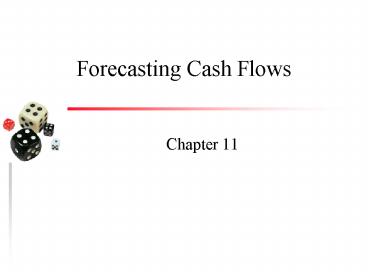Forecasting Cash Flows
1 / 31
Title: Forecasting Cash Flows
1
Forecasting Cash Flows
- Chapter 11
2
Why Forecast?
- Liquidity Management
- Financial Control
- Variation of Actual from Forecast
- Strategic Objectives
- Capital Budgeting
- Cost Management
- Optimize Cash Usage
- Exchange Rate Exposure Management
3
Forecasting Concerns
- Forecasting Horizons
- Short-Term
- Daily
- Weekly
- Monthly
- Medium-Term
- Up to 1 year
- Long-Term
- Over 1 year
- Degrees of Certainty
- Certain
- Interest, Royalties
- Tax Payments
- Predictable
- Collections
- Payroll
- Vendor Payments
- Less Predictable
- New Product Sales, etc.
4
Selecting a Forecast Method
- Establishing Data Relationships
- Relationships between available data and cash
flows. - Past Experience
- Trends
- Operating Relationships
- Selecting a Method
- Accurate Cost Effective
5
Testing and Validation
- In-Sample Validation
- Data used in model development
- Out-of-Sample
- Historical data not used in model development
- On-Going Validation
6
Forecasting Methods
- Receipts Disbursements
- Kinda Like a Cash Budget
- Short Medium Term Forecasting
- Cash Receipts Schedule
- Collections, Maturing Investments, etc.
- Cash Disbursements Schedule
- Vendor Payments, Payroll, Interest
7
Receipts and Disbursements Method
- Steps in the Process
- Develop a Sales Forecast for the Period
- Range of Possible Values
- Estimate Receipts
- Cash Sales
- Collections from Credit Sales
- Other Cash Receipts
- Estimate Cash Disbursements for the Period
- Payroll
- Vendor Payments
8
Receipts and Disbursements Method
- Net Cash Flow Receipts - Disbursements
- Subtract the Target (or Minimum) Cash Balance to
Obtain the Cash Surplus or Cash Shortfall.
9
Receipts and Disbursements Method
10
Forecasting Receipts from Credit Sales
11
Forecasting Receipts from Credit Sales
12
Forecasting Receipts from Credit Sales
- July Sales 20,250,000
- August Sales 19,500,000
- Forecasted September Sales 15,750,000
- Forecasted September Collections
- 0.25 x 20,250,000 5,062,500
- 0.50 x 19,500,000 9,750,000
- 0.25 x 15,750,000 3,937,500
- 18,750,000
13
Forecasting Methods
- Distribution Forecast
- Based on Historical Distributions of Cash Flows
- Averages
- Regression
- Estimate Percentage of Cash Inflows or
Disbursements on Particular Days or Weeks - Short-Term Forecasting
14
The Distribution Method of Forecasting
- Forecasted September Receipts
18,750,000 - You have determined that the monthly receipts are
typically distributed in the following manner - Week 1 - 26.7
- Week 2 - 13.3
- Week 3 - 32
- Week 4 - 28
15
The Distribution Method of Forecasting
- The Weekly Receipts Forecast Is
- Week 1 0.2667 x 18,750,000 5,000,000
- Week 2 0.1333 x 18,750,000 2,500,000
- Week 3 0.32 x 18,750,000 6,000,000
- Week 4 0.28 x 18,750,000 5,250,000
16
(No Transcript)
17
Forecasting Methods
- Percentage of Sales
- Determine the Relationships between Sales Levels
and Asset Accounts - Express Asset Accounts that Vary with Sales as a
Percentage of Sales - Multiple Percentages and Forecasted Sales
- Long-Term Forecasting
18
Percentage of Sales Forecasting
19
Percentage of Sales Forecasting
20
Time Series Forecasting
- Simple Moving Average
- Rolling Average of Past Historical Values
- Will Lag Trends in Actual Cash Flow
- Exponential Smoothing
- Ft1 axt (1 - a)Ft
21
Moving Averages
- Moving Averages Smooth the Past History Data
- The Moving Average Eliminates Some of the
Randomness in the Data - Each Average is Computed by Dropping the Oldest
Observation and Including the Next Observation
22
Moving Averages
23
Moving Averages
- Using Moving Average Smoothers to Estimate the
Trend-Cycle - A Larger Number of Observations Included in the
Moving Average will Result in a Smoother
Trend-Cycle
24
(No Transcript)
25
The Data with a 5 MA Smoother
26
Exponential Smoothing
- Allows a Greater Weight for More Recent
Observations - F t1 (? x Yt) (1 - ?) x (Ft)
- ? Smoothing Constant
- 0 lt ? lt 1
- A smoothing constant closer to 1.0 places more
weight on the most recent actual observation. - A smoothing constant closer to 0 places more
weight on the most recent forecast.
27
Exponential Smoothing
28
Regression
- Linear Regression Fits a Trend Line Through the
Data - The intercept and slope of the line are chosen to
minimize the sum of the squared error terms. - Yt a b(Y t-1) e
- Linear Regression is Used to Find the Optimal
Values of a and b.
29
Regression Models
30
Regression Models
31
Regression Models































